The Sad Loss Of At Least Two Buildings in the Mullanphy Historic District
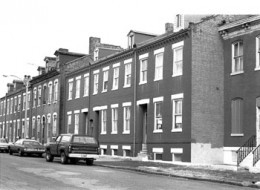 | 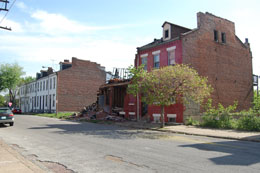 |
| 1608-26 N. 14th Street 1982 | 1608-26 N. 14th Street 2010 |
Described by Carolyn Toft in the 1982 nomination of the Mullanphy Historic District, these buildings were typical of German vernacular brickwork of the mid-19th century. Toft wrote "the block-long collection of buildings on north 14th Street facing the former Emigrant Home is an essay on St. Louis vernacular working-class houses built after the Civil War. All of red brick with stone trim, the two story tall wall they form is penetrated by four gangways or "mouseholes" to allow access from the street to the stairs for upstairs units...The portion of the streetscape at 1610-12-14 North 14th presents a three bay, four bay, three bay rythm. Germans were the first residents of this row with steep front steps recessed behind the front wall. Flat stone sills and lintels trim window openings; lintels above the front doors are slightly pointed. A narrow gangway is sandwiched between 1612 and 1614."
This description and the photos that were taken at the time are now, more than ever, historical documents as another piece of the tattered fabric of North St. Louis has disappeared. Another unfortunate aspect of this fire is that the destruction has dealt a blow to the Mullanphy Historic District. National Register Districts can be "de-listed" if, through demolition, collapse, fire, etc, they cease to retain sufficient integrity, or resemblance to their appearance at the time of nomination. As buildings burn or are pulled down by brick thieves (or both) some of our most fragile districts slip further toward the threat of de-listing and the resultant loss of redevelopment incentives like rehabilitation tax credits. These two buildings were owned by ACAK Corporation in care of Noble Development, a holding company that, according to Michael Allen, has been traced to developer Paul McKee. The privately-owned third section of the row, second from right, has been damaged and could quickly become unstable if its sidewall is not repaired. The buildings can be seen in the above photograph dating to 1982. The two that have collapsed completely are the third and fourth from the right. Since 1982, the building at the extreme right (partially visible) has been replaced with a vacant lot, as has the building fifth from the right effectively leaving the three attached buildings, up until now, as a somewhat isolated but quite intact group.
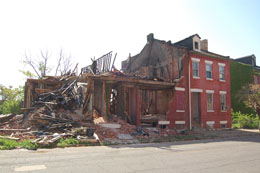 |
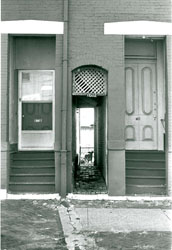 | 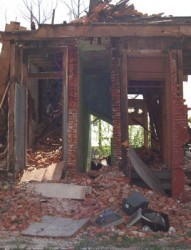 |
| Mousehole 1982 | Mousehole 2010 |
